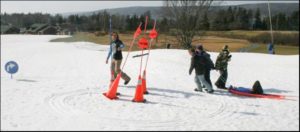Partnering with Ski-Hills for Active Learning

To view the photo-rich magazine version, click here.
Originally appears in the Summer 2017 issue
by Kathy Snow and Annamarie Hatcher
“Efforts to engage students in and through the natural environment go by many names… but the basic goal is this: to use the surrounding community, including nature, as the preferred classroom.” Richard Louv1
In regions that enjoy cold temperatures and snow each winter, you will often find small community-run ski parks. These local resources are much loved, but they are often underutilized. As we looked for a way to better engage the community near our ski park on Cape Breton Island in Nova Scotia, a dedicated group of volunteers joined forces to develop an outdoor classroom on the site. Our idea was to bring more children to the ski hill for diversified activities. We envisioned taking students’ annual ski trips beyond their normal focus on developing sports skills, so as to embrace other learning opportunities.
We know from research findings that nature deficits in young people can be associated with hyperactivity, obesity and other challenging issues for teachers. Re-connecting with nature through both unstructured and structured events has been shown to improve general health, well-being and academic achievement of school-age children.2,3,4
There are many reasons that outdoor classrooms are not as common as they should be. Teachers may feel trepidation around planning and conducting activities outside while still trying to meet curricular demands. Here in Cape Breton where the weather includes a long and highly variable winter, school boards are reluctant to fund outdoor classrooms that may only be used in warmer weather. With ever-tighter funding, teachers have to carefully justify the expense of a field trip. Beyond learning itself, another key factor is the safety of children. Safety concerns can spell the demise of a teacher’s well-intentioned outdoor lesson, regardless of cost. Fortunately, the infrastructure and user-friendliness of a ski hill can alleviate many of these tensions, because negotiating these issues is part and parcel of the general operation of the hill.
In this article, we’ll share our experience in the hopes that those living in regions with ski hills might develop similar collaborations to enrich outdoor learning during the winter months.
This content is restricted to subscribers only.
If you are not yet a subscriber, please consider taking out a subscription here.
If you are an existing subscriber, kindly log in or contact us at info@greenteacher.com for more information.





